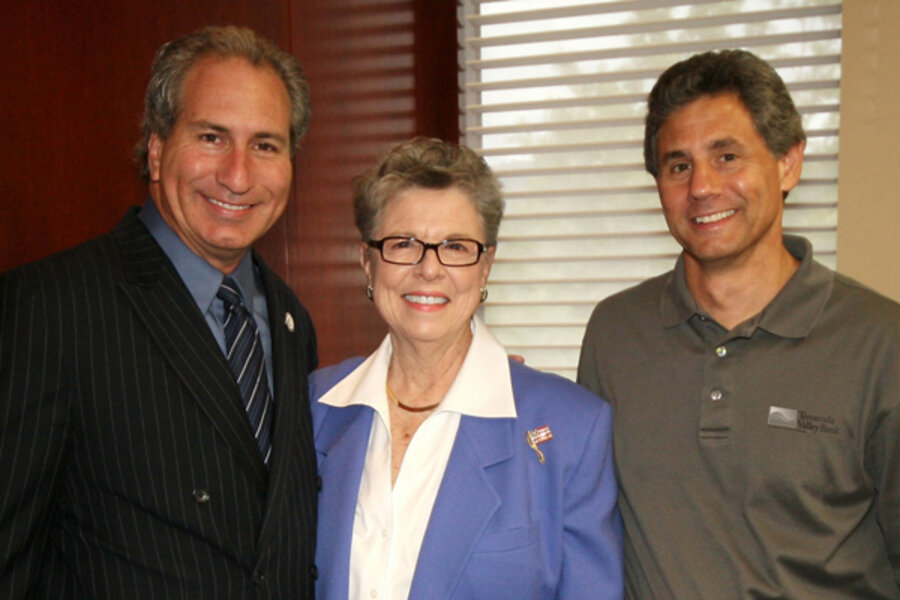51st state? Small step forward for long-shot 'South California' plan
Loading...
| Los Angeles
An effort to turn 13 southern California counties into the nation's 51st state took a small step forward Tuesday but remains an extremely long shot, say experts.
Four members of the Riverside County Board of Supervisors agreed Tuesday to allow a fifth member to convene a statewide meeting on the subject in the fall. Each of the four supervisors stated their objections to the secession idea, but went ahead and approved the idea of at least talking about it when Supervisor Jeff Stone said he would “personally see to it” that private funding, not public money, would be used to hold the meeting.
Since the days of the gold rush, more than 220 campaigns to split California into halves or thirds have been tossed around. Mr. Stone's vision involves persuading 13 counties to secede from the state, which he says raids local coffers to plug budget gaps.
Stone's idea has some merit, some analysts say. It addresses the problematic balance of power between Sacramento and California localities, as well as the political reality that the 13 counties in Stone's secession drive are far more conservative than the rest of the state. But the vision remains legally and politically unrealistic, many add, and is perhaps not the best solution to the problems it seeks address.
“Even if everyone in the 13 counties approved of partition, it would still require the approval of the California Legislature. Though theoretically possible, such approval is practically impossible,” says Jack Pitney, professor of government at Claremont McKenna College.
Nothing like Stone's plan has happened since West Virginia broke off from Virginia during the Civil War – and then “only because a rump legislature approved after the regular legislature joined the Confederacy,” says Professor Pitney.
Stone's South California would not include Los Angeles. In addition to Riverside County, the counties targeted for secession would be Fresno, Imperial, Inyo, Kern, Kings, Madera, Mariposa, Mono, Orange, San Bernardino, San Diego, and Tulare, which include about 13 million people total.
Republicans account for the majority of registered voters in all but two of the 13 counties – San Bernardino and Imperial. For that reason, the idea has merit, says Robert Stern, president of the Center for Governmental Studies.
He says the real division would not one between northern and southern California, but internal and coastal California. "This would divide the state in a way that makes political sense: liberals in coastal California and conservatives in east California," he adds. "It would allow the liberals to increase taxes to pay for those services they want, and the conservatives to reduce regulations and taxes in their state.”
Others are not so convinced that the division would be a good thing.
“Secession would be like a divorce, which typically leaves both spouses worse off economically. And like a divorce, it would be bad for the kids,” says Pitney. “The new state would now be responsible for services that California provides, such as regional centers for the disabled. And both sides would have to work out difficult issues, such as ‘custody’ of the University of California at Riverside and other state facilities.”
The plan did not receive enthusiastic approval at the public board meeting, either. Several of about a dozen, three-minute comments from local residents agreed with Stone’s comments that California is extremely hard to govern and needs some kind of overhaul. But some called him names and said they hoped his idea would flop. Some of the supervisors agreed to Stone’s motion to hold a meeting only because he agreed not to use public monies or staff time to convene it, and because the discussions would include other reforms.
Splitting the state is the wrong answer to the right issue, says James Mayer, executive director of California Forward, a nonpartisan, nonprofit organization working to bring government closer to the people.
“Indeed, California is too big, too diverse and too complex to be micromanaged by a dysfunctional legislature in the capital,” he says via e-mail.
But the answer, he adds, is to get the state to devolve more of its authority to localities, not to secede. His organization has spent the past two years holding gatherings all over the state to explore ways to give community-level government more authority and responsibility so they can tailor public programs to be responsive and effective in their communities.
“The governor and the Legislature – mostly motivated out of a desire to resolve the state's structural fiscal crisis – has started the process of shifting responsibilities to counties," he adds. "This evolution will take time, and much more needs to happen if it is going to deliver better results.”
In the meantime, Stone's secession bid could lead to useful conversation on the subject of what makes California so difficult to govern.
“In this case, even if secession does not occur – which is highly likely will not – it is worth talking about the reasons the idea is being floated at all,” says Jessica Levinson, director of political reform for the Center for Governmental Studies. “Is California too big to govern? Should we change the way we govern ourselves? Should we have more legislators, who are hopefully, more responsive to their constituents' needs? Should we have at-large elections? Proportional representation? Should we get rid of term limits so people get to know their legislators better?”





